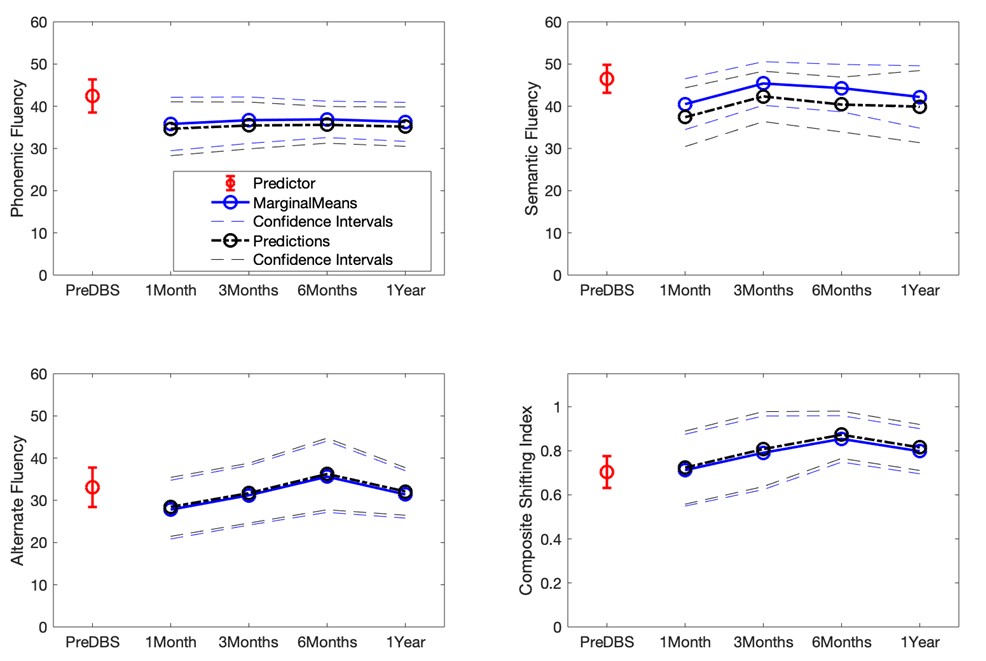Category: Parkinson's Disease: Cognitive functions
Objective: To study the impact of subthalamic nucleus deep brain stimulation (STN-DBS) on executive function using Alternate Fluency Test (AFT) and to investigate predictors for estimating cognitive decline after DBS in Parkinson’s disease (PD).
Background: PD is common indications for DBS procedure, some patients treated with STN-DBS develop new-onset cognitive decline. The most important predictor of a good postoperative outcome is proper patient selection. Normal cognition is an established selection criteria for STN-DBS in PD, while concern has been raised as to aggravated cognitive decline in PD patients following STN-DBS. We examined whether AFT can be used to predict cognitive deterioration in PD patients undergoing STN-DBS.
Method: 38 patients with PD without dementia (24 males, aged: 42-71) were selected for DBS treatment. We administered AFT to assess verbal fluency and set-shifting abilities before DBS surgery and at 4 time-point after surgery (1-3-6-12 months). This test combines phonemic and semantic fluencies and an alternate phonemic/semantic task.
For analyses, we used standard MATLAB functions provided with the Statistics and Machine Learning Toolbox (R2019b, The MathWorks). To assess time-point differences and to predict outcomes of the specific fluency metrics based on their pre-DBS value we employed a repeated-measurement ANOVA (rANOVA) using the Matlab function “fitrm”. The repeated measures model was fit considering all the fluences calculated when DBS was ON as the responses’ variable and each pre-DBS value as the predictor variable.
Results: After STN-DBS PD patients showed a stable trend of AFT. In [figure1] we show the marginal means and the confidence intervals calculated by the model at each specific time measurement (blue lines), the mean and the confidence interval of the predictor variable [pre-DBS, red circle; (mean±SD) Phonemic: 42.5±11.3; Semantic: 46.5±11.2; Alternate: 33.1±14.2; Composite Shift Index: 0.7±0.2] as well as the predictions for a given (mean) pre-DBS value for all the verbal fluencies.
Conclusion: Our preliminary data suggest that STN-DBS left executive functions unchanged and that preoperative AFT-score might be potentially used to identify PD patients that are at risk for developing cognitive decline after STN-DBS surgery even though their preoperative cognitive state was normal. To confirm our data, a larger sample size is needed.
To cite this abstract in AMA style:
R. Ferrucci, F. Mameli, F. Ruggiero, M. Reitano, S. Marceglia, M. Massei, L. Borellini, F. Cogiamanian, T. Bocci, M. Locatelli, S. Barbieri, A. Averna, A. Priori. Deep brain stimulation and cognitive decline in Parkinson’s disease: The predictive value of Alternate Fluency test [abstract]. Mov Disord. 2020; 35 (suppl 1). https://www.mdsabstracts.org/abstract/deep-brain-stimulation-and-cognitive-decline-in-parkinsons-disease-the-predictive-value-of-alternate-fluency-test/. Accessed December 30, 2025.« Back to MDS Virtual Congress 2020
MDS Abstracts - https://www.mdsabstracts.org/abstract/deep-brain-stimulation-and-cognitive-decline-in-parkinsons-disease-the-predictive-value-of-alternate-fluency-test/

